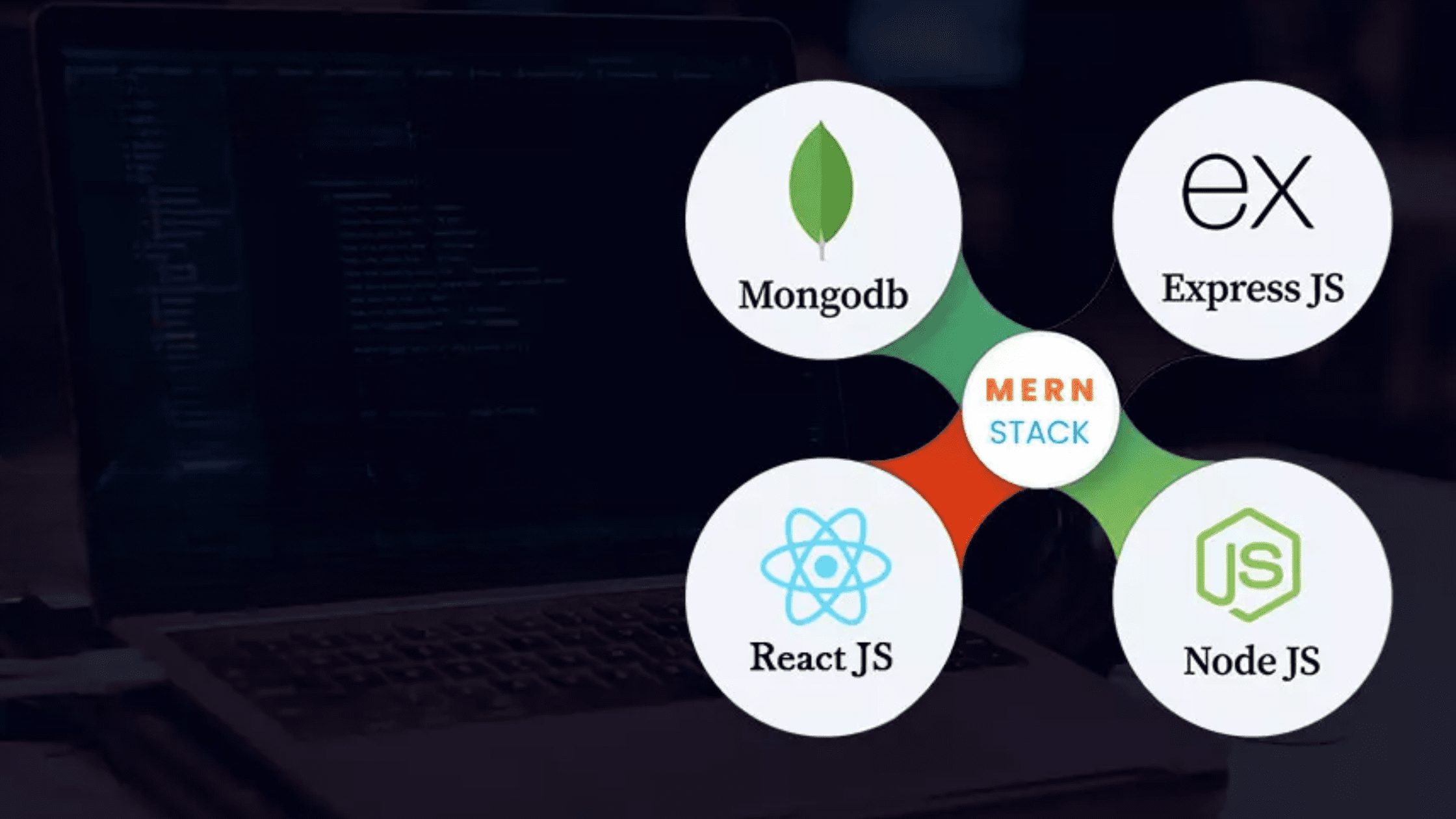The MERN stack Development is one stack that has become extremely popular recently with the powerhouse combination of MongoDB, Express.js, React.js, and Node.js. This technology combination provides a solid foundation for developing cutting-edge and dynamic web applications, making it a top choice for developers looking to create innovative solutions.
This article will cover the MERN stack’s components, examine its benefits, contrast it with other stacks, and discuss its bright future in the web development industry.
What is the MERN Stack?
The MERN stack is source-available JavaScript software stack that simplifies development by integrating four key technologies: MongoDB, Express.js, React.js, and Node.js. Each component plays a crucial role in building dynamic and efficient web applications. Let’s take a closer look at each of these technologies.
MERN Stack Components
MongoDB
It serves as the database layer in the MERN stack. It is a NoSQL database that stores data in a flexible, JSON-like format, making it well-suited for handling large volumes of unstructured data.
MongoDB’s scalability and ease of use make it a preferred choice for developers working on projects with varying data requirements.
Express.js
Express.js is a minimal and flexible Node.js web application framework that provides robust features for web and mobile applications.
It simplifies building scalable and maintainable server-side applications by offering a straightforward routing system and middleware support. Express.js smoothly integrates with MongoDB, forming a robust back-end foundation for MERN applications.
React.js
It is a JavaScript library developed by Facebook for building user interfaces. It allows developers to create reusable UI components, making the development process more modular and efficient.
React.js’s virtual DOM enables fast rendering of components, ensuring a smooth and responsive user experience. It serves as the front-end framework in the MERN stack.
Node.js
Node.js is a server-side JavaScript runtime that allows developers to build scalable, high-performance network applications.
It provides an event-driven architecture and a non-blocking I/O model, making it well-suited for building real-time applications. Node.js serves as the server-side runtime for MERN stack applications, facilitating smooth communication between the client and server.
Top Reasons to Choose MERN Stack Development
Now that we have a solid understanding of the MERN stack components let’s explore why developers are increasingly choosing MERN stack development for their projects.
Single Language, End-to-End Development
One of the most compelling reasons to opt for the MERN stack is using a single language, JavaScript, throughout the development process. From the server side with Node.js to the client side with React.js, developers can use JavaScript for both front-end and back-end development.
This unification simplifies the development workflow, reduces context switching, and accelerates the development cycle.
Rich Ecosystem and Community Support
The MERN stack benefits from a vibrant and active community of developers who contribute to the continuous improvement of individual technologies. The extensive documentation, tutorials, and a plethora of third-party libraries available for MongoDB, Express.js, React.js, and Node.js make it easier for developers to find solutions and address challenges.
This robust ecosystem ensures that developers can access a wealth of resources to enhance their skills and troubleshoot issues effectively.
Modular and Reusable Components
React.js, the front-end library in the MERN stack, is renowned for its component-based architecture. This approach enables developers to create modular and reusable components, fostering a more organized and maintainable codebase.
The ability to reuse components across different parts of an application accelerates development, enhances code consistency, and reduces the likelihood of errors.
High Performance with Virtual DOM
React.js employs a virtual DOM (Document Object Model) to optimize the rendering process. Instead of updating the entire DOM tree, React.js updates only the components that have changed. It minimizes the impact on performance, resulting in faster rendering and improved user experience.
The virtual DOM is a key factor in React’s ability to efficiently handle dynamic and data-intensive applications.
Scalability and Flexibility of MongoDB
MongoDB, being a NoSQL database, offers exceptional scalability and flexibility. Its schema-less design allows developers to adapt to changing data requirements without needing a predefined schema. It makes MongoDB well-suited for projects with evolving data structures and enables effortless scaling as application needs grow.
The automatic sharding capability of MongoDB further enhances its scalability, making it a preferred choice for large-scale applications.
Real-Time Capabilities with Node.js
Node.js, the server-side runtime in the MERN stack, is renowned for its event-driven, non-blocking architecture. It is particularly well-suited for building real-time applications like chat applications, online gaming platforms, and collaborative tools.
The ability to handle concurrent connections efficiently enhances the responsiveness of MERN stack applications, providing a smooth and interactive user experience.
Cross-Platform Development with React Native
While MERN is primarily associated with web development, React Native, a framework based on React.js, extends the MERN stack’s capabilities to mobile app development. Developers can leverage their existing knowledge of React.js to build cross-platform mobile applications, reducing the learning curve and accelerating the development of both web and mobile solutions.
Strong Industry Adoption and Demand
MERN stack development has gained widespread adoption across industries, and many large enterprises and startups are leveraging its benefits. The demand for MERN stack developers continues to grow, making it a valuable skill set in the job market.
Choosing MERN stack development equips developers with in-demand skills that open up many opportunities in the rapidly expanding field of web development.
Rapid Development and Time-to-Market
Combining a unified language, modular components, and a thriving ecosystem contributes to faster development cycles. MERN stack development allows teams to build feature-rich applications with reduced development time, enabling businesses to bring their products to market more quickly.
The efficiency gained through the MERN stack’s development process is a significant advantage in today’s competitive business landscape.
Easy Maintenance and Updates
The modular nature of MERN stack applications, coupled with the declarative syntax of React.js, facilitates more manageable maintenance and updates. Developers can change specific components without affecting the entire application, leading to more straightforward debugging and maintenance.
This ease of maintenance is crucial for long-term sustainability and the ability to adapt to evolving business requirements.
MERN Stack Vs. MEAN Stack
To better appreciate the advantages of the MERN stack, it’s worth comparing it to another popular full-stack JavaScript framework: the MEAN stack (MongoDB, Express.js, Angular.js, Node.js). Both stacks share similarities but differ in their front-end frameworks, with MERN using React.js and MEAN using Angular.js.
Front-End Frameworks: React.js vs. Angular.js
- React.js: Known for its simplicity and flexibility, React.js allows developers to build modular and reusable components. Its virtual DOM enables efficient rendering, contributing to high-performance web applications.
- Angular.js: Angular.js, developed by Google, is a comprehensive front-end framework with a steep learning curve. It provides a feature-rich ecosystem but may be perceived as more complex than React.js.
Learning Curve
- MERN Stack: The MERN stack is often considered more beginner-friendly due to the simplicity of React.js and the consistent use of JavaScript throughout the stack.
- MEAN Stack: Angular.js, with its comprehensive set of features, has a steeper learning curve, potentially requiring more time for developers to become proficient.
Flexibility and Community Support
- MERN Stack: React.js’s component-based architecture and the extensive JavaScript ecosystem contribute to flexibility and strong community support.
- MEAN Stack: While Angular.js offers a robust framework, some developers find it more opinionated, potentially limiting flexibility in specific scenarios.
Popularity and Industry Adoption
- MERN Stack: React.js has gained widespread popularity, and the MERN stack is widely adopted in the industry, with many high-profile companies using it for their web applications.
- MEAN Stack: MEAN stack has a solid presence in the industry, especially among enterprises, but React.js’s popularity has led to a higher demand for MERN stack development.
Future of MERN Stack Development
As technology advances, the MERN stack is well-positioned to remain a prominent choice for web development. Several factors contribute to the promising future of MERN stack development:
Continued Innovation in React.js
React.js is an open-source library with a vibrant community actively contributing to its evolution. Continuous updates, new features, and improvements ensure that React.js remains at the forefront of modern front-end development. Developers can expect ongoing support and innovation in React.js, enhancing the capabilities of MERN stack applications.
MongoDB’s Adaptability to Changing Data Trends
MongoDB’s schema-less design and flexibility make it adaptable to changing data trends and evolving business requirements. As the demand for data-driven applications continues to grow, MongoDB’s ability to handle diverse data structures positions it as a reliable choice for developers seeking scalability and adaptability.
Node.js for Real-Time and Serverless Architectures
Node.js’s event-driven architecture and non-blocking I/O make it well-suited for real-time applications and serverless architectures. As the demand for real-time capabilities and serverless computing increases, Node.js will likely play a crucial role in shaping the future of MERN stack development.
Cross-Platform Development with React Native
Expanding MERN stack capabilities to mobile app development through React Native enhances its relevance in a multi-platform landscape. As businesses seek cost-effective solutions for web and mobile applications, React Native’s cross-platform development capabilities contribute to the enduring appeal of the MERN stack.
Conclusion
The MERN stack is a powerful choice for modern web development, smoothly integrating MongoDB, Express.js, React.js, and Node.js. Its single-language approach, rich ecosystem, and real-time capabilities make it versatile. Compared to MEAN, MERN excels in flexibility, ease of learning, and industry demand. Ongoing innovations in React.js, MongoDB’s adaptability, and Node.js’s real-time capabilities ensure a promising future.
As businesses prioritize scalability, consider partnering with our Canadian Software Agency for top-notch MERN stack web app development. Explore cutting-edge possibilities with us.





